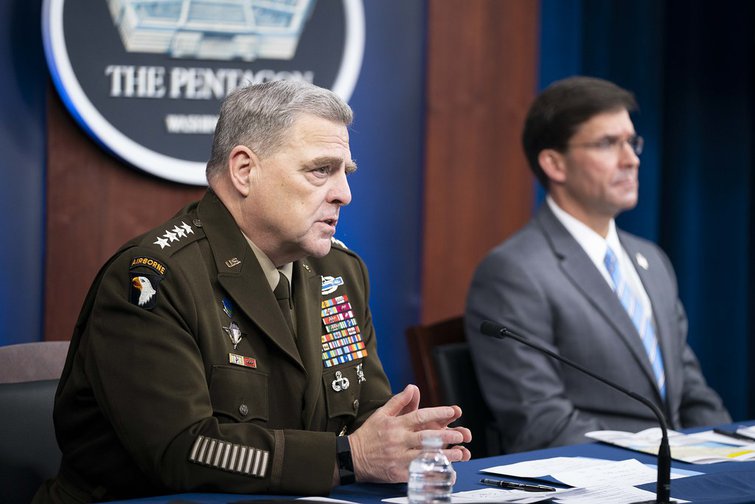A hasty withdrawal puts the Afghan government and NATO in the emboldened Taliban’s firing line.
By Paul Rogers. Published 12-4-2020 by openDemocracy

Joint Chiefs of Staff Army General Mark Milley | Navy Petty Officer 1st Class Carlos M. Vazquez II, DOD, CC BY 2.0
The United States responded to the 9/11 attacks by terminating the Taliban regime in Afghanistan and quashing al-Qaida. At the time there was widespread domestic support for the action and most allied states were also in agreement, at least at first. A few analysts were more cautious and the openDemocracy view at the time was that al-Qaida wanted a war, to show how significant it was but also to trap Western forces in Afghanistan and drag the United States down in much the same way as Soviet Union had been in the 1980s.
Now, there are signs that precisely that is happening, with the Afghan government and the Taliban agreeing to an outline of how negotiations on a peace settlement might be achieved. This comes after two months of talks in Qatar that have really been between the United States and the Taliban. The main topic of the talks was the withdrawal of all uniformed US forces by next May in return for a Taliban ceasefire and a pledge from Taliban leadership that they would not allow al-Qaida or ISIS to maintain a presence in the country.
In reality, this is the tailend of the Trump plan to “bring our boys back” come what may, an intent that has been pursued with ruthless determination and already to considerable effect. Eight years ago, the Pentagon had close to 100,000 troops in the country, but that shrank to barely 10,000 a year ago. By last month it was down to 4,500 and it will decrease still further to 2,500 by 15 January, the week before the inauguration of the president-elect, Joe Biden.
The US military is making the best of it but the truth is that, come what may, the US is getting out. Earlier this week, the chairman of the Joint Chiefs of Staff, Army General Mark Milley, conceded that the Taliban could not be defeated. Speaking at a Brookings Institution meeting in Washington on 2 December, he said:
We believe now that after 20 years, two decades of consistent effort, that we have achieved a modicum of success. With the blessings of providence in the coming year, we will finish this generational war and bring our men and women home. We will protect our children from the heavy burden and toll of perpetual war. And we will honour the sacrifices made in service to peace and stability in Afghanistan, Iraq and around the world, and celebrate all those who helped us secure freedom over oppression.
Since October 2001, more than 2,400 American troops have died and nearly 21,000 have been injured in this war. The economic cost has been exorbitant – with $1 trillion spent so far, most recently on efforts to ensure that Afghanistan won’t in future harbour groups intent on attacking the United States.
Milley may claim a “modicum of success” but this is little short of risible. Just last month, gunmen massacred 22 people on the Kabul University campus, just one of many attacks the country faces every week, and last Sunday 34 soldiers were killed in two separate suicide bombings of Afghan government forces.
Dreadful mistake
Even as the talks continued in Qatar, the Taliban have maintained their offensive, concentrating on Afghan forces and mostly leaving Western troops alone. The aim is to see off the foreigners while undermining the Afghan government, all the time giving the impression that what they want is peace. In a sense this is true, but the key point is that their kind of peace means dominating the Afghan countryside and eventually taking over the whole government.
Furthermore, the US military’s retreat leaves its NATO allies in a mess. There are 11,000 personnel from NATO states in the country on a wide variety of training and stabilisation operations. These personnel are not specifically in combat roles and are dependent on US resources for much of their logistics, transport and even protection.
The US retreat means that other NATO states have no choice but to pull out most of their own people, a further gift to the Taliban and other armed opposition groups. In all likelihood, unless Biden slows down the withdrawal, most of the NATO units will have left Afghanistan by the end of the year.
For Afghanistan, the cost of the war has been huge – with 157,000 people killed over the nineteen years, including more than 43,000 civilians and hundreds of thousands more injured. The war has led to around 2.5 million Afghans becoming refugees; the highest for any state in Asia.
However much its generals’ try to sugarcoat it, the US withdrawal from Afghanistan is yet another acknowledgement of the dreadful mistake that was the ‘war on terror’.
This article is published under a Creative Commons Attribution-NonCommercial 4.0 International licence

